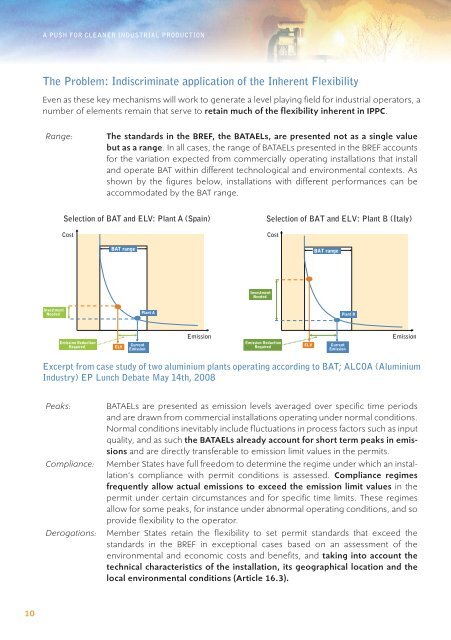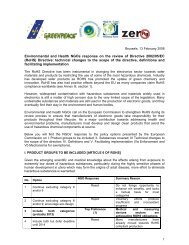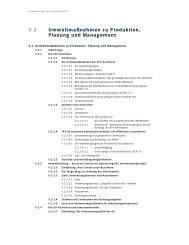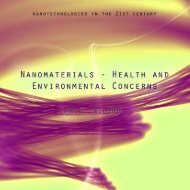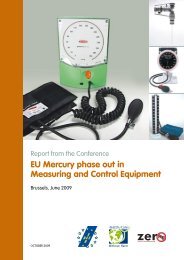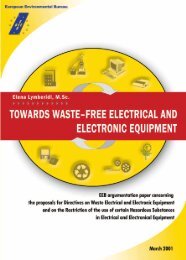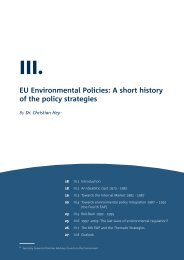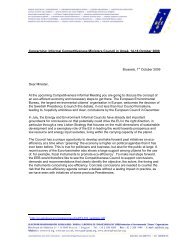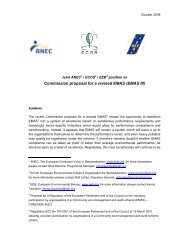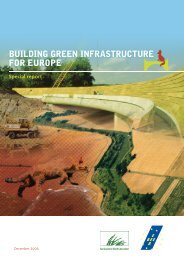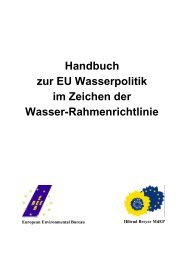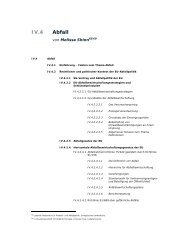A push for cleaner industrial production - EEB
A push for cleaner industrial production - EEB
A push for cleaner industrial production - EEB
Create successful ePaper yourself
Turn your PDF publications into a flip-book with our unique Google optimized e-Paper software.
A PUSH FOR CLEANER INDUSTRIAL PRODUCTION<br />
The Problem: Indiscriminate application of the Inherent Flexibility<br />
Even as these key mechanisms will work to generate a level playing field <strong>for</strong> <strong>industrial</strong> operators, a<br />
number of elements remain that serve to retain much of the flexibility inherent in IPPC.<br />
Range:<br />
The standards in the BREF, the BATAELs, are presented not as a single value<br />
but as a range. In all cases, the range of BATAELs presented in the BREF accounts<br />
<strong>for</strong> the variation expected from commercially operating installations that install<br />
and operate BAT within different technological and environmental contexts. As<br />
shown by the figures below, installations with different per<strong>for</strong>mances can be<br />
accommodated by the BAT range.<br />
Selection of BAT and ELV: Plant A (Spain)<br />
Cost<br />
BAT range<br />
Selection of BAT and ELV: Plant B (Italy)<br />
Cost<br />
BAT range<br />
Investment<br />
Needed<br />
Investment<br />
Needed<br />
Plant A<br />
Plant B<br />
Emission Reduction<br />
Required<br />
ELV<br />
Current<br />
Emission<br />
Emission<br />
Emission Reduction<br />
Required<br />
ELV<br />
Current<br />
Emission<br />
Emission<br />
Excerpt from case study of two aluminium plants operating according to BAT; ALCOA (Aluminium<br />
Industry) EP Lunch Debate May 14th, 2008<br />
Peaks:<br />
Compliance:<br />
Derogations:<br />
BATAELs are presented as emission levels averaged over specific time periods<br />
and are drawn from commercial installations operating under normal conditions.<br />
Normal conditions inevitably include fluctuations in process factors such as input<br />
quality, and as such the BATAELs already account <strong>for</strong> short term peaks in emissions<br />
and are directly transferable to emission limit values in the permits.<br />
Member States have full freedom to determine the regime under which an installation’s<br />
compliance with permit conditions is assessed. Compliance regimes<br />
frequently allow actual emissions to exceed the emission limit values in the<br />
permit under certain circumstances and <strong>for</strong> specific time limits. These regimes<br />
allow <strong>for</strong> some peaks, <strong>for</strong> instance under abnormal operating conditions, and so<br />
provide flexibility to the operator.<br />
Member States retain the flexibility to set permit standards that exceed the<br />
standards in the BREF in exceptional cases based on an assessment of the<br />
environmental and economic costs and benefits, and taking into account the<br />
technical characteristics of the installation, its geographical location and the<br />
local environmental conditions (Article 16.3).<br />
10


